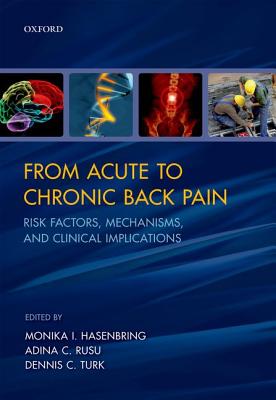图书简介
Chronic back pain continues to be a major cause of distress, disability, work loss, and a huge cost to society. This book examines the risk factors and mechanisms involved in the transition from acute to chronic back pain. It integrates genetic, biomechanical, neurobiological, psychophysiological, psychosocial, and socieconomic risk factors.
Preface; Section I: Current developments in epidemiology; 1 Blair H. Smith, Nicola Torrance, Gary J. Macfarlane: Epidemiology of back pain, from the laboratory to the bus stop: psychosocial risk factors, biological mechanisms and interventions in population-based research?; 2 Kate M Dunn, Peter R Croft: Defining chronic pain by prognosis; Section II: Risk Factors of chronic back pain and disability: Biological Mechanisms; 3 Julia Metzner and Irmgard Tegeder: Genetic factors modulating chronic back pain; 4 Hermann Handwerker: Peripheral and central sensitization as risk factors of low back pain; 5 John McBeth and Andrea Power: Dysfunction of the hypothalamic-pituitary-adrenal axis and associated stress axes in the development of chronic LBP; 6 Sandra Kamping and Herta Flor: Central imaging of pain and the process of chronicity; 7 Arne May and A. Vania Apkarian: Structural brain changes in patients with chronic back pain; 8 Kati Thieme and Richard H. Gracely: The Psychophysiology of Chronic Back Pain Patients; Section III: Risk Factors of chronic back pain and disability: Biomechanical Mechanisms; 9 A.F. Mannion and D. O’Riordan: Electromyographically-determined Muscular Fatigue in Low Back Pain; 10 Jeanine Verbunt, Robert Smeets, and Harriet Wittink: Unmasking the Deconditioning Paradigm for Chronic Low Back Pain Patients.; Section IV: Risk Factors of chronic back pain and disability: Sociodemographic and psychosocial mechanisms; 11 Chris J. Main, Nicholas A.S. Kendall, and Monika Hasenbring: Screening of Psychological Risk Factors (Yellow Flags) for Chronic Back Pain and Disability; 12 R. Nicholas Carleton and Gordon J.G. Asmundson: Dispositional fear, anxiety sensitivity, and hypervigilence; 13 Michael JL Sullivan and Marc O. Martel: Processes Underlying the Relation between Catastrophizing and Chronic Pain: Implications for Intervention; 14 Linda Vancleef, Ida Flink, and Steven Linton: Fear-avoidance as a risk factor for the development of chronic back pain and disability; 15 Monika I. Hasenbring, Dirk Hallner, and Adina C. Rusu: Endurance?related pain responses in the development of chronic back pain; 16 Adina C Rusu and Tamar Pincus: Cognitive processing and self-pain enmeshment in chronic back pain; 17 Annmarie Cano and Laura Leong: Significant others in the chronicity of pain and disability; 18 James P. Robinson and John D. Loeser: Effects of Workers’ Compensation Systems on Recovery from Disabling Injuries; 19 William S. Shaw Glenn S. Pransky and Chris J. Main: Work-related risk factors for transition to chronic back pain and disability; Section V: Practitioner’s role in the process of care; 20 James Rainville, Glenn Pransky, Sarah Gibson, and Pradeep Suri: The Physician as Disability Advisor for Back Pain Patients; 21 Tamar Pincus, Rita Santos, and Steven Vogel: The attitudes and beliefs of clinicians treating back pain: Do they affect patients’ outcome?; Section VI: Clinical Implications - New approaches to Diagnostics and Treatment; 22 Maurits van Tulder and Bart Koes: International guidelines for the diagnostics and treatment of acute, sub-acute and chronic back pain; Section VII: Clinical approaches for patients with acute and subacute LBP; 23 Chris J. Main and Kim Burton: Engaging patients in their own care for back care: the role of education and advice in the prevention of chronic pain and disability; 24 Robert D. Kerns, Mark P. Jensen, and Warren R. Nielson: Motivational Issues in Pain Management; 25 Kay Brune and Bertold Renner: Pharmacotherapy of Low Back Pain; Section VIII: Subgroup-specific approaches for patients at risk for or with chronic pain; 26 Adina C. Rusu, Katja Boersma, and Dennis C. Turk: Reviewing the concept of subgroups in sub-acute and chronic pain and the potential of customizing treatments; 27 Monika I. Hasenbring, Bernhard W. Klasen, Adina C. Rusu: Risk factor based cognitive behavioral therapy for acute and subacute back pain; Section IX: Clinical approaches for patients with established pain and disability; 28 JB Staal, CG Maher, and WS Shaw: Physical exercise interventions and low back pain; 29 Lance M. McCracken: Contextual cognitive behavioral therapy for chronic pain (including back pain); 30 MK Nicholasa and RJEM Smeets: Rehabilitation programs to prevent severely disabling chronic back pain
Trade Policy 买家须知
- 关于产品:
- ● 正版保障:本网站隶属于中国国际图书贸易集团公司,确保所有图书都是100%正版。
- ● 环保纸张:进口图书大多使用的都是环保轻型张,颜色偏黄,重量比较轻。
- ● 毛边版:即书翻页的地方,故意做成了参差不齐的样子,一般为精装版,更具收藏价值。
关于退换货:- 由于预订产品的特殊性,采购订单正式发订后,买方不得无故取消全部或部分产品的订购。
- 由于进口图书的特殊性,发生以下情况的,请直接拒收货物,由快递返回:
- ● 外包装破损/发错货/少发货/图书外观破损/图书配件不全(例如:光盘等)
并请在工作日通过电话400-008-1110联系我们。
- 签收后,如发生以下情况,请在签收后的5个工作日内联系客服办理退换货:
- ● 缺页/错页/错印/脱线
关于发货时间:- 一般情况下:
- ●【现货】 下单后48小时内由北京(库房)发出快递。
- ●【预订】【预售】下单后国外发货,到货时间预计5-8周左右,店铺默认中通快递,如需顺丰快递邮费到付。
- ● 需要开具发票的客户,发货时间可能在上述基础上再延后1-2个工作日(紧急发票需求,请联系010-68433105/3213);
- ● 如遇其他特殊原因,对发货时间有影响的,我们会第一时间在网站公告,敬请留意。
关于到货时间:- 由于进口图书入境入库后,都是委托第三方快递发货,所以我们只能保证在规定时间内发出,但无法为您保证确切的到货时间。
- ● 主要城市一般2-4天
- ● 偏远地区一般4-7天
关于接听咨询电话的时间:- 010-68433105/3213正常接听咨询电话的时间为:周一至周五上午8:30~下午5:00,周六、日及法定节假日休息,将无法接听来电,敬请谅解。
- 其它时间您也可以通过邮件联系我们:customer@readgo.cn,工作日会优先处理。
关于快递:- ● 已付款订单:主要由中通、宅急送负责派送,订单进度查询请拨打010-68433105/3213。
本书暂无推荐
本书暂无推荐















